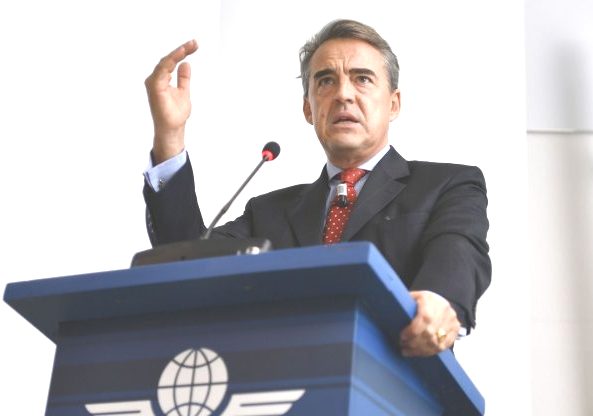African carriers see traffic rise amidst zero profits
 De Juniac said the year has started on a positive note, with healthy passenger demand in line with the 10-year trend line.
De Juniac said the year has started on a positive note, with healthy passenger demand in line with the 10-year trend line.
March 21—African airlines saw January traffic rise 5.1 percent, up from 3.8 percent in December, but prospects for profit remain dim due to high overheads in the region.
However Ethiopian Airlines, the continents biggest, continues to buck the trend posting a $233 million net profit for financial year 2017/18 compared to $229 million the previous 12 months.
In its latest findings, IATA, the international airlines umbrella, said sub-Saharan Africa capacity rose 2.9 percent, and load factor jumped 1.5 percentage points to 70.9 pc. Load factor is an indicator that measures the percentage of available seating capacity that is filled with passengers.
IATA Director General and CEO Alexandre de Juniac said on Wednesday, “Twenty nineteen has started on a positive note, with healthy passenger demand in line with the 10-year trend line.
“However, market signals are mixed, with indications of weakening business confidence in developed economies and a more nuanced picture across the developing world,” he said.
International passenger demand grew six percent compared to January 2018, up 0.7% from December’s year-on-year figure of 5.3 percent, as Europe led the way for a fourth consecutive month.
All regions recorded demand growth, with capacity increasing 5.8% and load factor climbing 0.2 percentage point to 79.8 pc.
Last year, African airlines traffic rose 6.5 percent compared to 2017, which was an increase compared to 6 percent annual growth in 2017. Capacity rose 4.4 percent, and load factor jumped 1.4 percentage points to 71.0%.
All regions, except Africa, are expected to report profits in 2018 and 2019. In December IATA forecast the global airline industry net profit to be $35.5 billion in 2019. IATA said total African carrier loss in 2019 could reach $300 million compared to the $400 million in 2018.
De Juniac said at the time, “We had expected that rising costs would weaken profitability in 2019. But the sharp fall in oil prices and solid GDP growth projections have provided a buffer.
“So we are cautiously optimistic that the run of solid value creation for investors will continue for at least another year. But there are downside risks as the economic and political environments remain volatile,” he said.
Carriers in North America continue to lead on financial performance, accounting for nearly half of the industry’s total profits.
Lower oil prices and solid, albeit slower, economic growth are extending the run of profits for the global airline industry, after profitability was squeezed by rising costs in 2018.
The forecasted figures are slightly ahead of the $32.3 billion expected net profit in 2018, which was revised down from $33.8 billion forecast in June.

 African Heads of state head to South Korea next week for Summit talks
African Heads of state head to South Korea next week for Summit talks
 Trading leads as main source of income for Ugandans
Trading leads as main source of income for Ugandans
 Unpacking results-based financing: balancing strengths with weaknesses
Unpacking results-based financing: balancing strengths with weaknesses
 Women social entrepreneurs offered chance to visit New York
Women social entrepreneurs offered chance to visit New York
 Why and how economics must change
Why and how economics must change
 Stanbic Bank Uganda Chief Executive elevated to regional role in Nairobi
Stanbic Bank Uganda Chief Executive elevated to regional role in Nairobi
